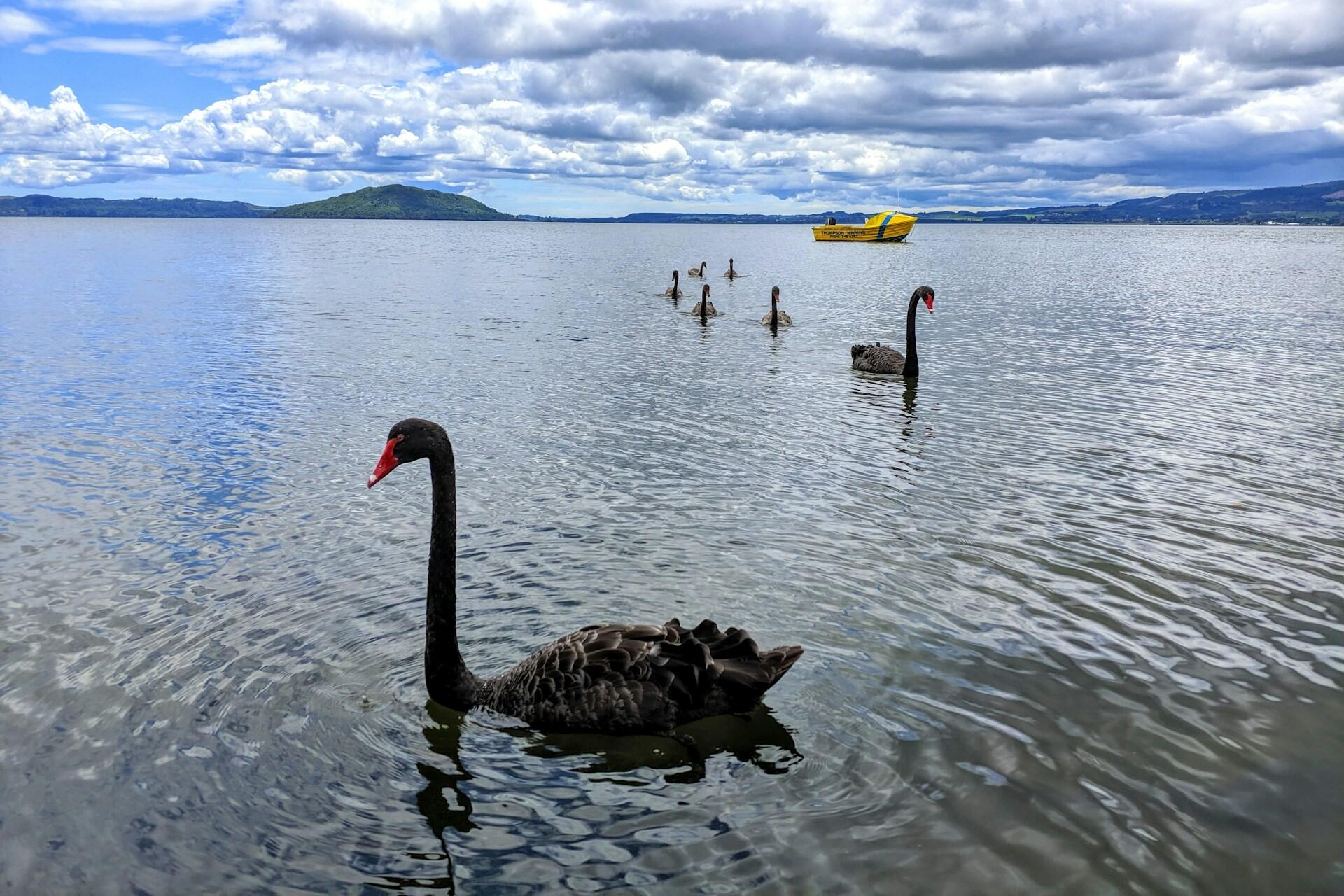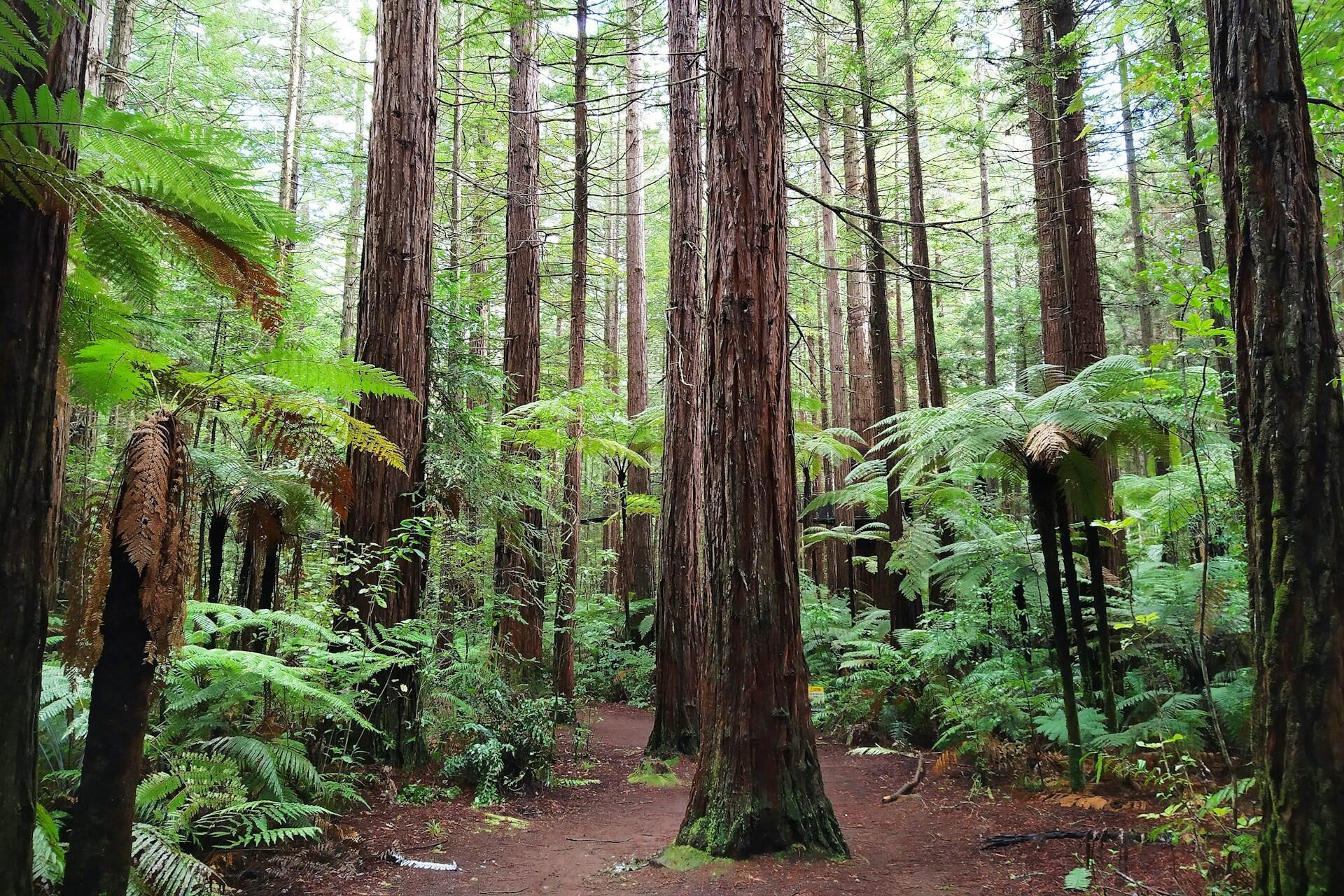One of the most culturally rich aspects of Māori culture is the pūrākau (legends) and traditions that are passed down through the generations via a rich oral tradition. Many of these stories originate from the first Polynesian settlers to arrive in Aotearoa (New Zealand) from Hawaiki, and they serve many purposes, including explaining how the world was created, how the land was shaped, and the interconnectedness of people, nature, and the divine. These can include the daring exploits of Māui, the life-giving work of Tāne Mahuta, and many other stories that form the foundation of many aspects of Māori culture. Let's look at some of the most important and influential ones.
| Name | Domain | Description |
|---|---|---|
| Ranginui (Sky Father) | Sky, heavens | The Sky Father, source of light and the celestial realm. Central to Māori creation narratives. |
| Papatūānuku (Earth Mother) | Earth, land, life | Earth Mother who nurtures all living things. Her separation from Ranginui created the world of light. |
| Tāne Mahuta | Forests, birds, creation | One of the most important Māori gods; separated Ranginui and Papatūānuku and brought Te Ao Mārama into existence. |
| Tangaroa | Sea, marine life | Atua of the ocean and all sea creatures; governs tides, navigation, currents, and Māori relationships with the sea. |
| Tāwhirimātea | Weather, winds, storms | Sent storms and winds in anger after the separation of his parents. Represents climate, seasons, and natural forces. |
| Tūmatauenga | War, humanity, strength | Atua of war, hunting, and human behaviour. Ancestor of humankind; symbol of courage, discipline, and resilience. |
| Rongo-mā-Tāne | Peace, cultivated foods | Atua of agriculture, harmony, and community wellbeing. Protector of crops like kūmara and cultivated food sources. |

Tāne Mahuta: One of the Most Important Māori Gods
Māori mythology's explanation of light is wonderful. Like other creation stories, it begins with a world in darkness, Te Pō. This was caused because Ranginui (Sky Father) and Papatūānuku (Earth Mother) were locked in a tight embrace. Their many children were weary of the perpetual night and wanted to bring light into the world.
One of their children, Tāne Mahuta, pushed his parents apart, separating the sky from the land and creating Te Ao Mārama, the world of light.
Tāne Mahuta separated Ranginui (Sky Father) and Papatūānuku (Earth Mother), creating the world of light, Te Ao Mārama, while enduring his sibling Tāwhirimātea's wrath.
You'd have thought this new world of light would have been popular, but Tāwhirimātea, the god of wind and storms, was angry and joined his father in the sky. To this day, the conflict between Tāwhirimātea persists, with Tāwhirimātea regularly sending storms, winds, and rain to punish his siblings for what they'd done.
Tāne Mahuta, in case you were wondering, is the god of forests and birds, and he used his power to create the first human and nurture the giant kauri trees of the North Island's Waipoua Forest. The creation of humans by Tāne Mahuta links humans to gods and the natural world.
hectares in the North Island of New Zealand, according to the Department of Conservation.
Māui and His Legendary Deeds in Māori Mythology
This is another Māori creation story. In this one, Māui-tikitiki-a-Taranga, or simply Māui, created the North Island (Te Ika-a-Māui).

Māui is known for being clever, brave, and mischievous. When he and his brothers set out on a fishing trip, he hid in their canoe. When they were out to see, he cast a magical fishhook from an ancestral jawbone into the ocean while chanting a powerful incantation. He caught a giant fish, Te Ika-a-Māui, which was special. He told his brothers not to cut the fish without honouring Tangaroa, the god of the sea. However, they carved into the fish, creating the valleys, mountains, and lakes of the North Island as the fish thrashed about.
In some legends, his canoe is the South Island, and Stewart Island is known as Te Punga a Māui (Māui's anchor) and Māui, like many others, wears traditional Māori tattoos for each of his major achievements.
Māui used an ancestral jawbone as a fishhook to pull up the North Island, with its valleys and mountains forming as a result of his brothers' disrespect.
Kupe the Navigator: An Ancestral Figure in Māori Tradition
This legend is more grounded than the other examples of deities and their exploits. In this legend, Kupe is the Polynesian explorer credited with discovering Aotearoa (New Zealand). The story isn't just the tale of Kupe's personal achievement. It's also the narrative for many Māori iwi (tribes), who trace their ancestry and origins back to him.
In the story, Kupe journeys from Hawaiki, the mythical homeland of the Māori and other Polynesian peoples. Not to be confused with Hawai'i, Hawaiki's exact location is uncertain, but it is generally thought to be the islands in East Polynesia, like Raiatea in the Society Islands.

In the legend of Kupe, he embarked on a voyage in a waka hourua (double-hulled voyaging canoe), which was likely adorned with traditional patterns, using celestial navigation, ocean currents, and the natural world to guide him. Different versions of the legend provide various reasons for his journey. Still, one of my favourites is that he was pursuing a giant octopus (wheke) that was depleting the fishing grounds.
Kupe and his crew chased the octopus, Te Wheke-a-Muturangi, across the Pacific Ocean, ending in a showdown in Cook Strait, the body of water separating the North Island from the South Island. Kupe's wife, Kuramārotini, named the new land. As the canoe approached, she exclaimed, "He ao! He ao! He Aotearoa!" which means "A cloud! A cloud! A long white cloud!" The name Aotearoa stuck and remains the Māori name for New Zealand today.
Kupe discovered Aotearoa while pursuing a giant octopus, with his wife naming the land "Aotearoa" (land of the long white cloud).

The Love Story of Hinemoa and Tūtānekai
This love story is often likened to a Māori version of Romeo and Juliet. It includes similar themes of passion, determination, and defiance. In it, a beautiful, high-born woman named Hinemoa falls in love with Tūtānekai, a handsome young man considered of lesser status than Hinemoa. The two met during a gathering of local tribes, and their attraction was immediate and powerful. They fell deeply in love.
Hinemoa's family believed that Tūtānekai's lower social standing made him an unsuitable partner for Hinemoa and forbade their union. The family took extreme measures to keep the two apart, including removing all the canoes (waka) from the shores of Lake Rotorua so Hinemoa couldn't cross to Mokoia Island, where Tūtānekai lived.
Tūtānekai, however, was a skilled flute player who played music across the water every night, a symbol of his love and devotion to Hinemoa. Ultimately, she decided to be with Tūtānekai by swimming across the cold, treacherous waters of Lake Rotorua. She wrapped calabashes around herself to stay afloat and swam across the water on a moonlit night.

When she reached Mokoia Island, she went to a warm spring called Waikimihia and soaked in its waters to recover. Though he didn't immediately recognise her in the darkness, Tūtānekai came to see what was happening, as he had heard someone near the spring. When he realised it was her, the two embraced. This story is about aroha (love and devotion), determination, courage, whānau (family), and connection to the land and water.
This legend features deep symbolism and reflects many important aspects of Māori culture, including resourcefulness, respect, exploration, and the interconnectedness of land and myth.
What Are Māori Atua?
Māori atua are spiritual beings or Māori gods who hold authority over natural elements, emotions, and aspects of the world. They appear throughout Māori legends and whakapapa.
Why Atua Matter in Māori Legends
Stories of Māori gods shape how Māori understand creation, the environment, and ancestry. Knowing the atua helps explain who the Māori gods are and their roles.
Paikea the Whale Rider: A Key Figure in Māori Ancestral Stories
The story of Paikea, the Whale Rider, is one of the most popular Māori legends and another that recounts the actions of another ancestor. In it, the courageous Paikea journeys to Aotearoa (New Zealand) on the back of a whale! Need I say more?
Paikea, also known as Kahutia-te-rangi, was the son of Uenuku, a great chief of Hawaiki, the Māori people's ancestral homeland. Paikea's brother Ruatapu was angry after his father publicly shamed him. Ruatapu lured Paikea and his other brothers out to sea and sabotaged the canoe once it was out to sea, casting his brothers into the ocean. Paikea's brothers perished in the sea, but Paikea survived by calling upon the gods and ancestors for help.
Tohorā, the great whale, came to his help. Paikea climbed onto the whale's back and was carried across the ocean to safety. Paikea arrived at Whāngārā, a coastal area of the Tairāwhiti Gisborne region, which became his home. He's regarded as the Ngāti Porou iwi (tribe) that traces its ancestry to him. As a result, the Tairāwhiti region and Whāngārā hold great significance for the descendants of Paikea. They are a constant reminder of this legend.
Paikea's story is one of resilience, hope, Whakapapa (genealogy), and a connection to nature, which is often seen in Māori symbols. The ancestral myths of Paikea inspire both a book and a film, Whale Rider.
people were estimated to be part of the Māori population in Aotearoa/New Zealand.
The Tarawera Eruption: A Legend Intertwined With Māori Belief
This story is a legend clearly based on a historical event. The Tarawera Eruption, which occurred on June 10th, 1886, was one of the most devastating natural disasters in New Zealand's recorded history. The eruption reshaped the physical landscape and left a mark on the Māori people and their cultural narratives.
Before the eruption, the spectacular Pink and White Terraces (Te Otukapuarangi and Te Tarata) were silica sinter deposits and a natural wonder of the world. These terraces were a sacred and cherished site for the local Tūhourangi iwi, and both locals and Europeans would soak in the terraces' thermal waters.
Legend has it that sightings of a ghostly canoe on Lake Tarawera foreshadowed the disaster. The canoe vanished into the mist, a bad omen, a warning from the spirits that something terrible was about to happen.
A ghostly canoe sighted on Lake Tarawera was seen as an omen of the volcanic eruption that buried sacred Pink and White Terraces and nearby villages.
When Mount Tarawera erupted, there were explosions, the sky filled with ash, fire, and volcanic rock, and a fissure stretched over 17 kilometres. The nearby villages of Te Wairoa, Mouraea, and Te Ariki were destroyed and buried under thick layers of ash and mud. Dozens died, and the Pink and White Terraces disappeared to be replaced by ash and destruction. Many Māori people interpret the events as a consequence of disrespecting the land with the ghost canoe as a final warning.
The Legend of Kurangaituku and Hatupatu
Kurangaituku is a supernatural being, often described as a wāhine tipua (mystical woman). She lived deep in the forest near Rotorua. She's usually depicted with bird-like features, including feathers, talons, and a long beak or as a guardian of birds. She's the embodiment of the wild, untamed forest and its spiritual power. There are many different tellings of her stor,y and in many versions, she's a protector of birds and a solitary guardian of the ngahere. She's a complex figure with both fierce and compassionate aspects.
Hatupatu was a young man from a local iwi. He wandered into Kurangaituku’s forest territory while hunting. Kurangaituku found him either injured or lost, depending on the version of the story, and took him into her care. She brought him back to her cave, where she kept a collection of pet birds with magical or enhanced features. She nursed Hatupatu back to health, fed him, and let him live with her.
Hatupatu started to grow afraid and sometimes resentful of Kurangaituku. While she was out hunting one day, Hatupatu slaughtered her birds, raided her home, and attempted his escape. When Kurangaituku returned home to find her beloved birds dead, she let out a cry and gave chase. She could run faster than humans and gained on Hatupatu. As Kurangaituku got closer, Hatupatu saw a rock formation and cried out:
“Hatupatu! Hatupatu! kei roto i te kō!”
(“Hatupatu, Hatupatu, into the rock!”)
The rock opened, and he hid inside. It closed before Kurangaituku arrived, and she clawed at the rock, trying to reach Hatupatu. A few different endings depend on who tells the story. Still, Kurangaituku either falls into a boiling hot pool, retreats, or is portrayed as right, whose actions are completely justified given what Hatupatu did.

This story is considered to represent the guardianship of nature, the sacredness of the forest, and the protection of wildlife. It's a lesson in betrayal and consequence, and it ties nicely to the area's geographic identity, with real-life locations represented.
If you want to see or hear even more legends, enjoy this video in teo reo Māori telling the story of the battle of the mountains.
| Name | Domain | Description |
|---|---|---|
| Rehua | Stars, healing, high heavens | A powerful atua associated with the stars and wellbeing. Linked to birds and celestial knowledge. |
| Whiro | Darkness, chaos | Atua of darkness, sickness, and disorder. Often representing challenges and imbalance. |
| Hine-nui-te-pō | Night, death, transition | Goddess of night and the underworld. Guides souls and represents endings and transformation. |
| Hine-te-iwaiwa | Moon cycles, childbirth, weaving | Atua of childbirth, weaving, and the moon. Protector of wāhine and traditional mātauranga. |
| Tama-nui-te-rā | The Sun | The personified Sun, bringing light, warmth, and the natural rhythms of day. |
| Marama | The Moon | Personification of the Moon, governing tides, cycles, and measurement of time. |
| Hine-ahu-one | First human woman created by Tāne | The first woman formed by Tāne from the earth; central to whakapapa and origins of humanity. |
| Hine-tītama | Dawn, new beginnings | Goddess of dawn who later becomes Hine-nui-te-pō, symbolising the cycle of life and renewal. |















